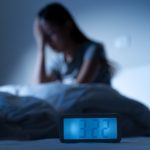
Eating disorders (EDs) are mental health conditions characterised by disordered eating, and excessive focus on weight and body image. These disorders are often comorbid with anxiety and depression (Galmiche et al., 2019) and may be linked to sleep impairments.
Research suggests that sleep disturbances can exacerbate mental health problems, with reduced sleep linked to increased depression (Hamilton et al., 2023) and a higher risk of developing psychosis (Morales-Muñoz et al., 2024). Treatments for insomnia have been shown to alleviate psychiatric symptoms (Freeman et al., 2017), indicating that addressing sleep disturbances could have a knock-on impact on clinical outcomes. But what about in the context of eating disorders?
To explore this further, Degasperi et al. (2024) conducted a systematic review and meta-analysis investigating sleep in individuals with Anorexia Nervosa (AN; involving extreme caloric restriction), Bulimia Nervosa (BN; involving binge-purge cycles), and Binge Eating Disorder (BED; involving binge eating alone) compared to healthy controls. The authors wanted to better understand sleep deficits in ED patients, including their causes and impact on treatment.

Difficulties with sleep are known to exacerbate mental health problems, including eating disorders.
Methods
Search strategy
Three databases were searched in December 2023 using keywords related to EDs and sleep. Studies were eligible for inclusion if they:
- Included subjective or physiological sleep data
- Were in English, Italian, German, or Spanish
- Used a case-control design with ≥10 participants
- Involved patients with DSM-5 or ICD-10 diagnosed eating disorders.
However, studies were excluded if they included overlapping samples (only the largest or most recent study was retained), used non-standard sleep quality metrics, had missing outcome data, or did not differentiate between ED subtypes.
Titles, abstracts, and full texts were reviewed by two independent assessors, before data extraction and quality assessment using the CASP checklist for case-control studies. Most studies showed low risk in relation to aims and validity, but uncertainty and higher risk in relation to control groups and confounding variables.
Measures
Physiological sleep outcomes were categorised as:
- Sleep continuity, including sleep efficiency, sleep onset latency, total sleep time, and wake after sleep onset (WASO)
- Sleep depth, including proportions of N1, N2, N3 (which are different stages in non-rapid eye movement [REM] sleep) and slow-wave sleep in total sleep time
- REM pressure, including REM latency (intervals between sleep onset and the first REM stage), REM density (frequency of rapid eye movement), and REM percentage during total sleep time.
Subjective sleep assessments included the Pittsburgh Sleep Quality Index (PSQI), the Morningness-Eveningness Questionnaire (MEQ), MEQ-reduced (MEQ-r), and sleep diaries.
Analysis
A meta-analysis was conducted using random effects models, with effect sizes calculated as standardised mean differences (Cohen’s d).
Results
Study characteristics
Twenty-seven studies met the eligibility criteria, with 24 included in the meta-analysis. Most studies had small patient samples (average n = 21), focused on young females (98.7%) and were conducted in Italy (n = 9) or the USA (n = 8). Most studies focused on AN patients (n = 14), whilst BN (n = 8) and BED (n = 7) were underrepresented.
Main findings
Compared to controls, ED patients exhibited:
- Increased WASO (wake after sleep onset), with a small effect (d = 0.49, p < 0.005)
- Reduced sleep efficiency, with a medium effect (d = 0.78, p < 0.001
- Shorter total sleep time, with a small effect (d = 0.38, p < 0.001)
- Less slow-wave sleep, with a small effect (d = 0.44, p < 0.001)
- Lower subjective sleep quality (PSQI), with a large effect (d = 0.95, p < 0.05)
AN patients showed more severe sleep disturbances than BN and BED, with:
- Increased WASO (wake after sleep onset), with a medium effect (d = 0.67, p < 0.01)
- Reduced sleep efficiency, with a large effect (d = 0.90, p < 0.001)
- Reduced total sleep time, with a medium effect (d = 0.51, p < 0.0001)
- Reduced slow-wave sleep, with a medium effect (d = 0.74, p < 0.01)
Not enough studies were available to conduct meta-analyses on self-reported sleep quality and circadian preferences, the effect of ED treatment on sleep quality, or sleep disorders in ED patients. However, a narrative synthesis highlighted that one study found significantly lower MEQ-r scores in ED patients, suggesting an evening circadian preference (i.e., waking up late and going to bed late), and that a reduction in ED symptoms over time while undergoing CBT was associated with increased MEQ-r (i.e., waking up early and going to bed early). However, three other studies on the effects of treatment in AN patients found inconsistent results, highlighting that there is a lot we still don’t know.
Publication bias
Heterogeneity tests (p < 0.20, I² ≥ 50%) and abnormal distributions from funnel plots indicated a risk of publication bias, affecting sleep efficiency and PSQI data.

In comparison to healthy controls, patients with eating disorders exhibited shorter total sleep time, reduced sleep efficiency, and more fragmented sleep, collectively indicating poorer overall sleep.
Conclusions
In the largest meta-analysis to date on this topic, Degasperi et al. (2024) found that ED patients experience significant sleep impairments in comparison to healthy controls, including shorter, more fragmented sleep with reduced efficiency and depth. According to the authors’ calculations,
In an average month, a patient with an eating disorder sleeps about 630 minutes less, spends 180 minutes less in deep sleep, and is awake 450 minutes longer than the general population.
AN patients also showed significantly greater sleep disturbances than other ED subtype, potentially indicating that factors disproportionately affecting AN patients (e.g., low BMI, malnutrition) could contribute to greater sleep deficits. ED patients also had a stronger evening chronotype, aligning with broader research linking evening rhythms to psychopathologies (Kivelä et al., 2018; Merikanto & Partonen, 2021). However, much further research is needed, as the lack of studies prevented a proper meta-analytic exploration of this pattern.

In comparison to patients with bulimia and binge eating disorder, patients with anorexia showed significantly greater sleep disturbances.
Strengths and limitations
Strengths
The researchers followed a robust methodology in relation to identify a specific question to answer, sourcing papers and then using clear inclusion and exclusion criteria. They then used the CASP checklists to assess the robustness of the each of the papers identified.
This study included diverse ED populations (AN, BN, BED) and both subjective and objective sleep measures, maximising statistical power and allowing comparisons between ED subtypes. This increases the reliability of the study, as well as its explanatory power in helping us to understand what underlying factors could be driving these associations. The inclusion of both self-reported and physiological data is a particular strength given wider debates in research regarding the accuracy of these different approaches in capturing sleep.
Limitations
As the authors have noted, an intrinsic limitation of a systematic review and meta-analysis is that the quality depends wholly on the quality of the included studies. Unfortunately, this meta-analysis highlighted a lack of studies in certain areas, such as patients with BN and BED. As such, it is difficult to determine whether the findings of reduced sleep quality among ED patients is valid, or whether it is simply driven by more pronounced sleep deficits among AN patients. More research is needed to confirm the presence of sleep deficits among all types of EDs. Equally, findings of more pronounced sleep deficits in AN patients must also be considered tentative as there were few studies containing BN and BED patients, limiting this analysis. These issues reflect gaps in current literature as well as a potential missed opportunity to include grey literature which might have increased available evidence on these topics.
Authors also calculated a high risk of publication bias in their analysis which could be related to not including any grey literature. A high risk of publication bias suggests the studies included in the analysis may reflect current popular ideas on sleep and EDs rather than real life relationships between EDs and sleep deficits, making results from the meta-analysis less reliable.
Additionally, in-keeping with a general lack of diversity in ED literature (Egbert et al., 2022), the studies included in the meta-analysis lacked diversity, particularly with respect to socioeconomic status and non-European populations. This negatively impacts the ability to generalise findings of sleep deficits in EDs to non-white lower socioeconomic status groups whose mental health may be influenced by different factors (e.g. social stressors).
This meta-analysis also struggled to identify the causes of sleep deficits in EDs. It’s unclear whether EDs lead to sleep disturbances or whether poor sleep contributes to EDs. More research is needed to clarify the direction of this relationship and the impact of ED treatment on sleep in order to develop better clinical guidance on approaching this in treatment.

This study provides evidence that EDs are linked to sleep deficits, though the underlying factors and impact on treatment remain unclear.
Implications for practice
Given the significant sleep deficits that patients with EDs exhibit, this meta-analysis highlights the importance of considering sleep in clinical practice with this population. Ensuring that discussion of sleep disturbances is part of initial assessments with ED patients seems like a good starting point, allowing clinicians to establish if this is an issue and whether it needs to be prioritised. Clinicians may decide to address sleep issues as part of ED treatment, as poor sleep increases the risk of other mental health issues (Kahn-Greene et al., 2007) and could potentially hinder treatment efficacy according to the depression literature (Zhang et al., 2024).
Future research should explore whether improving sleep quality can support ED recovery or vice versa, alongside investigating the role of malnutrition and low BMI in sleep deficits in AN patients. Future research should also control for confounding factors like anxiety and depression, which are common comorbidities linked to sleep deficits (Kahn-Greene et al., 2007).

Addressing sleep deficits may enhance ED treatment and recovery – or maybe vice versa?
Statement of interest
None.
Links
Primary paper
Degasperi, G., Meneo, D., Curati, S., Cardi, V., Baglioni, C., & Cellini, N. (2024). Sleep quality in eating disorders: A Systematic Review and Meta-Analysis. Sleep Medicine Reviews, 101969.
Other references
Egbert, A. H., Hunt, R. A., Williams, K. L., Burke, N. L., & Mathis, K. J. (2022). Reporting racial and ethnic diversity in eating disorder research over the past 20 years. International Journal of Eating Disorders, 55(4), 455-462.
Freeman, D., Sheaves, B., Goodwin, G. M., Yu, L.-M., Nickless, A., Harrison, P. J., … Wadekar, V. (2017). The effects of improving sleep on mental health (OASIS): a randomised controlled trial with mediation analysis. The Lancet Psychiatry, 4(10), 749-758.
Galmiche, M., Déchelotte, P., Lambert, G., & Tavolacci, M. P. (2019). Prevalence of eating disorders over the 2000–2018 period: a systematic literature review. The American Journal of Clinical Nutrition, 109(5), 1402-1413.
Hamilton, O. S., Steptoe, A., & Ajnakina, O. (2023). Polygenic predisposition, sleep duration, and depression: evidence from a prospective population-based cohort. Translational Psychiatry, 13(1), 323.
Kahn-Greene, E. T., Killgore, D. B., Kamimori, G. H., Balkin, T. J., & Killgore, W. D. (2007). The effects of sleep deprivation on symptoms of psychopathology in healthy adults. Sleep Medicine, 8(3), 215-221.
Kivelä, L., Papadopoulos, M. R., & Antypa, N. (2018). Chronotype and psychiatric disorders. Current Sleep Medicine Reports, 4, 94-103.
Merikanto, I., & Partonen, T. (2021). Eveningness increases risks for depressive and anxiety symptoms and hospital treatments mediated by insufficient sleep in a population‐based study of 18,039 adults. Depression and Anxiety, 38(10), 1066-1077.
Morales-Muñoz, I., Marwaha, S., Upthegrove, R., & Cropley, V. (2024). Role of inflammation in short sleep duration across childhood and psychosis in young adulthood. JAMA Psychiatry.
Zhang, Q., Tong, M., Ji, Y., Hou, Y., Lou, Z., Wu, D., … Zhu, Z. (2024). The impact of sleep disturbances on treatment efficacy and prognosis in patients with depressive and anxiety disorders. Frontiers in Psychiatry, 15, 1432538.
Photo credits
- Photo by Greg Pappas on Unsplash
- Photo by Abbie Bernet on Unsplash
- Photo by Sander Sammy on Unsplash
- Photo by Ousa Chea on Unsplash
- Photo by Alex Haney on Unsplash
